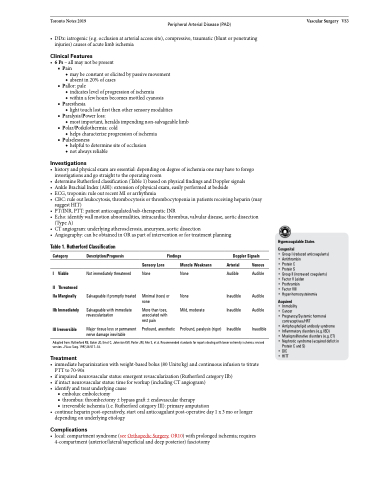Page 1367 - TNFlipTest
P. 1367
Toronto Notes 2019 Peripheral Arterial Disease (PAD)
• DDx:iatrogenic(e.g.occlusionatarterialaccesssite),compressive,traumatic(bluntorpenetrating
injuries) causes of acute limb ischemia
Clinical Features
• 6Ps–allmaynotbepresent ■ Pain
◆ may be constant or elicited by passive movement
◆ absent in 20% of cases ■ Pallor: pale
◆ indicates level of progression of ischemia
◆ within a few hours becomes mottled cyanosis ■ Paresthesia
◆ light touch lost first then other sensory modalities ■ Paralysis/Power loss:
◆ most important, heralds impending non-salvageable limb ■ Polar/Poikilothermia: cold
◆ helps characterize progression of ischemia ■ Pulselessness
◆ helpful to determine site of occlusion ◆ not always reliable
Investigations
• historyandphysicalexamareessential:dependingondegreeofischemiaonemayhavetoforego investigations and go straight to the operating room
• determineRutherfordclassification(Table1)basedonphysicalfindingsandDopplersignals
• AnkleBrachialIndex(ABI):extensionofphysicalexam,easilyperformedatbedside
• ECG,troponin:ruleoutrecentMIorarrhythmia
• CBC:ruleoutleukocytosis,thrombocytosisorthrombocytopeniainpatientsreceivingheparin(may
suggest HIT)
• PT/INR,PTT:patientanticoagulated/sub-therapeuticINR
• Echo:identifywallmotionabnormalities,intracardiacthrombus,valvulardisease,aorticdissection
Vascular Surgery VS3
(Type A)
• CTangiogram:underlyingatherosclerosis,aneurysm,aorticdissection
• Angiography:canbeobtainedinORaspartofinterventionorfortreatmentplanning
Table 1. Rutherford Classification
Hypercoagulable States
Congenital
• Group I (reduced anticoagulants) • Antithrombin
• Protein C
• Protein S
• Group II (increased coagulants) • Factor V Leiden
• Prothrombin
• Factor VIII
• Hyper-homocysteinemia
Acquired
• Immobility
• Cancer
• Pregnancy/Systemic hormonal
contraceptives/HRT
• Antiphospholipid antibody syndrome
• Inflammatory disorders (e.g. IBD)
• Myeloproliferative disorders (e.g. ET)
• Nephrotic syndrome (acquired deficit in
Protein C and S)
• DIC
• HITT
Category
I Viable
II Threatened IIa Marginally
IIb Immediately III Irreversible
Description/Prognosis
Not immediately threatened
Salvageable if promptly treated
Salvageable with immediate revascularization
Major tissue loss or permanent nerve damage inevitable
Findings
Muscle Weakness
None
None
Mild, moderate
Profound, paralysis (rigor)
Doppler Signals
Sensory Loss
None
Minimal (toes) or none
More than toes, associated with rest pain
Profound, anesthetic
Arterial
Audible
Inaudible Inaudible
Inaudible
Venous
Audible
Audible Audible
Inaudible
Adapted from: Rutherford RB, Baker JD, Ernst C, Johnston KW, Porter JM, Ahn S, et al. Recommended standards for reports dealing with lower extremity ischemia: revised version. J Vasc Surg. 1997;26:517–38.
Treatment
• immediateheparinizationwithweight-basedbolus(80Units/kg)andcontinuousinfusiontotitrate PTT to 70-90s
• ifimpairedneurovascularstatus:emergentrevascularization(RutherfordcategoryIIb)
• ifintactneurovascularstatus:timeforworkup(includingCTangiogram)
• identifyandtreatunderlyingcause
■ embolus: embolectomy
■ thrombus: thrombectomy ± bypass graft ± endovascular therapy
■ irreversible ischemia (i.e. Rutherford category III): primary amputation
• continueheparinpost-operatively,startoralanticoagulantpost-operativeday1x3moorlonger depending on underlying etiology
Complications
• local:compartmentsyndrome(seeOrthopedicSurgery,OR10)withprolongedischemia;requires 4-compartment (anterior/lateral/superficial and deep posterior) fasciotomy


